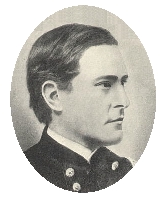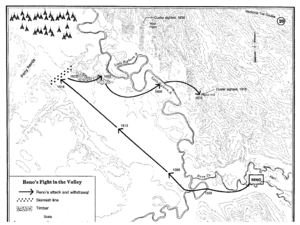Marcus Reno facts for kids
Quick facts for kids
Marcus Albert Reno
|
|
|---|---|

Marcus A. Reno
|
|
| Born | November 15, 1834 Carrollton, Illinois, US |
| Died | March 30, 1889 (aged 54) Washington, D.C., US |
| Allegiance | United States Union |
| Service/ |
United States Army Union Army |
| Years of service | 1857–1880 |
| Rank | |
| Unit | 1st U.S. Cavalry Regiment 7th U.S. Cavalry Regiment |
| Commands held | 12th Pennsylvania Cavalry Regiment |
| Battles/wars | Indian Wars American Civil War |
| Alma mater | United States Military Academy Class of 1857 |
Marcus Albert Reno (born November 15, 1834 – died March 30, 1889) was a military officer from the United States. He served in the American Civil War and later under George Armstrong Custer in the Great Sioux War. This war was fought against the Lakota (Sioux) and Northern Cheyenne tribes.
Reno is best known for his important part in the Battle of the Little Bighorn. During this battle, he did not join Custer's main forces. Instead, he stayed in a defensive position with his troops about 4 miles away. This decision has been debated for a long time. It is a key part of one of the most well-known defeats in U.S. military history.
Contents
Early Life and Military Start
Marcus Albert Reno was born on November 15, 1834, in Carrollton, Illinois. His parents were James Reno and Charlotte (Hinton) Miller. Marcus was one of six children. His mother passed away when he was 13 years old.
When he was 15, Reno wanted to join the military. He wrote to the Secretary of War to learn how to enter the United States Military Academy at West Point, New York. He was accepted and attended West Point from 1851 to 1857. He graduated on June 28, 1857, ranking 20th in his class of 38. He became a brevet second lieutenant in the 1st U.S. Dragoons.
Civil War Service
In 1858, Reno was sent to Fort Walla Walla in Washington Territory. When the Civil War began, his unit was renamed the 1st Cavalry Regiment. They moved to Washington, D.C., in January 1862. Reno, now a captain, fought in the Battle of Antietam. He was injured at the Battle of Kelly's Ford in Virginia in March 1863. His horse was shot and fell on him.
After recovering, he returned to fight in July 1863 at the Battle of Williamsport. He was recognized for his brave actions during these battles. In 1864, Reno took part in several more battles, including Cold Harbor and Cedar Creek. For his service at Cedar Creek, he was promoted to lieutenant colonel.
In January 1865, he became a colonel in the 12th Pennsylvania Volunteer Cavalry. He later led a brigade against John Mosby's guerrillas. Reno was also made a brevet colonel in the Regular Army (United States) for his "meritorious services during the war." In March 1866, he was promoted to brevet brigadier general.
After the Civil War
After the war, Reno briefly taught at West Point. He then served in New Orleans and later at Fort Vancouver. In December 1868, he was promoted to major. In July 1871, he joined the 7th Cavalry. By October 1875, he was with the full regiment at Fort Abraham Lincoln.
The Battle of the Little Bighorn
In June 1876, Marcus Reno was the second-highest officer under Custer at the Battle of the Little Bighorn. Custer planned for Reno, with three companies of soldiers, to attack the Native American village from the south. Custer, with five companies, would attack from the north. Captain Frederick Benteen was sent with three companies to check the area south of the camp. Captain Thomas McDougall's company guarded the supplies.
The cavalry officers did not realize how large the Native American village was. Historians believe there were many warriors, possibly up to 3,500. This meant the Native American forces greatly outnumbered Custer's command.
Reno's Attack and Retreat
Reno rode towards the village. As his troops came into view, he ordered them to stop and prepare to fight on foot. He later said he felt he was being led into a trap. At first, there were only a few Native American warriors. But soon, hundreds of warriors surrounded Reno's troops.
Reno and his men fell back into the trees near the river. An Arikara scout named Bloody Knife was shot and killed next to Reno. Reno then led a quick retreat across the river and up the hills. His retreat turned into a disorganized rush. Here, he met Captain Benteen and his three companies. Reno told Benteen, "For God's sake, Benteen! Halt your command and help me! I've lost half my men!" At this point, 40 of Reno's 140 men were dead, and 7 were wounded.
Soon after, the pursuing warriors turned away and headed north. Two miles back, McDougall heard gunfire. The troops with Benteen and Reno also heard it. However, both Reno and Benteen later said they did not hear the shots. They did not immediately move forward to find out what was happening. This later led to accusations that they had left Custer.
The Defense on Reno Hill
Concerned about Custer, Captain Thomas Weir rode north toward the sound of gunfire. He was followed by his company. From a spot now called Weir Point, they could see dust and smoke about three miles further north. They saw many warriors coming towards them.
Benteen arrived and decided they should retreat to a better defensive spot. This place is now known as "Reno Hill." Captain McDougall and the supply train also arrived. Benteen quickly set up a horseshoe-shaped defensive line on the hills. They were attacked immediately and throughout the rest of the day.
As night fell, the attacks slowed. The Native American village was celebrating. The next morning, the fighting continued until the afternoon. The soldiers then saw the village breaking up and the tribes moving south. On the morning of June 27, General Alfred Terry and Colonel John Gibbon found the surviving troops. Thirteen soldiers received the Medal of Honor for their bravery in the battle. However, Reno faced much criticism.
Later Military Career and Legacy
After the Battle of the Little Bighorn, Reno was given command of Fort Abercrombie, Dakota Territory. In 1879, Reno asked for a court of inquiry to look into the accusations of cowardice against him at Little Bighorn. The court met in Chicago in January 1879. Many surviving officers from the battle gave their testimony.
After 26 days, the court concluded that Major Reno was not guilty of cowardice. They stated that the idea Custer's death was due to Reno's failure to help him was "set to rest." However, this court of inquiry did not change public opinion much. Some soldiers later said they were pressured to give positive reports about Reno.
In 1967, at the request of Charles Reno, Marcus Reno's great-nephew, a U.S. military review board looked at Reno's past military record. They decided that his dismissal from the service in 1880 was not proper. They awarded him an honorable discharge.
On September 9, 1967, Marcus Reno's remains were reburied with honors at the Custer National Cemetery. This cemetery is on the Little Bighorn battlefield itself. Reno was the only person who fought in the Battle of Little Bighorn to be buried with such honors at the cemetery named after his former commander.
Personal Details
When he joined West Point, Reno was about 5 feet 8 inches tall and weighed around 145 pounds. He had dark hair, brown eyes, and a dark complexion. While serving at Fort Vancouver, Reno became a Freemason.
Portrayals in Films and Television
Marcus Reno has been shown in several films and television shows:
- Liam Sullivan played Colonel Marcus Reno in a 1960 episode of Cheyenne.
- Joseph Cotten played Major Reno in the 1965 movie, "The Great Sioux Massacre".
- Ty Hardin played Reno in the 1967 film Custer of the West.
- William Daniels played him in the 1977 TV movie The Court-Martial of George Armstrong Custer.
- Michael Medeiros played Reno in the 1991 television mini-series Son of the Morning Star.
Images for kids
See also
- List of American Civil War brevet generals (Union)
- White Swan
- Half Yellow Face





